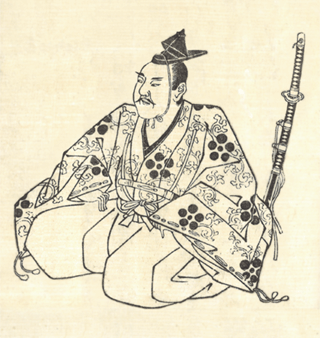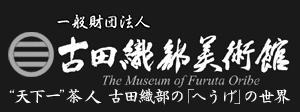The Museum of Furuta Oribe
Address: General Incorporated Foundation The Museum of Furuta OribeB1, 107-2 Kamigamo Sakurai-cho, Kita-ku, Kyoto
(Opposite Kyoto Botanical Gardens)
3-min walk from Exit 4, Kitayama Subway Station, Karasuma Line.
30 min. from Kyoto Station by taxi.
TEL: 075-707-1800
OPEN: 9:30 to 17:00 (Last admission 16:40)
Aug 31, Sep8, 2019 9:30to18:30(Last admission18:10)
Sep1, 3, 5, 6, 7, 2019 9:30to21:00(Last admission20:40)
Sep2, 4, 2019 9:30to21:30(Last admission21:10)
Closed during New Year holiday and exhibition changes.
admission fee:
Adults, 500yen / Students (high school to university), 400yen /
Junior high school and under, 300yen / Pre-school, Free / Groups of 15 and above, 100yen discount
About Furuta Oribe Museum
FURUTA ORIBE (1543-1615), known commonly as SHIGENARI. Who was after the death of Sen no Rikyu, referred to as the "First under Heaven" warlord tea master by Hideyoshi.
Though Oribe did not gain great military fame, he did excel in TEA and in RENGA or group poetry composition. After Nobunaga's violent death regent Hideyoshi chose him to be one of his inner staff, where he also went on to work under Hideyoshi's son, Hidenori. Oribe went on to serve under the succeeding shoguns, Tokugawa Ieyasu and his son, Hidetada, until ordered to commit suicide by Ieyasu.
Continuing in the footsteps of Tea master Sen no Rikyu, Oribe was successful at producing tea utensils, architecture and gardens. His design style is referred to as "Oribe gonomi". It was extremely popular from 1593 till his death in 1615 and continued in popularity until 1644.
When "Oribe" or " Oribe wares" first come to mind, one most likely has the image of green glaze on a mukozuke dish or an unusual design on a "shoe-shaped" tea bowl. Even with the turmoil that prevailed in the later part of the Momoyama period then into the Keicho period, Oribe gonomi tea utensils continued to lead in popularity.
Today, you the viewer may, find it hard to believe that these works are some 400 years old. They continue to excite and seem so ahead of their time that we have created this museum, so as to give you the public the opportunity to further your knowledge of them.
This museum may be a small in size, but we hope that we are able to offer you a small window into the "World of Oribe".
This museum will give you some facts behind the man, Furuta Oribe, as we hope that it will help in the understanding of the world of Japanese TEA itself.
Furuta Oribe Museum Director
Miyashita Harumasa
Though Oribe did not gain great military fame, he did excel in TEA and in RENGA or group poetry composition. After Nobunaga's violent death regent Hideyoshi chose him to be one of his inner staff, where he also went on to work under Hideyoshi's son, Hidenori. Oribe went on to serve under the succeeding shoguns, Tokugawa Ieyasu and his son, Hidetada, until ordered to commit suicide by Ieyasu.
Continuing in the footsteps of Tea master Sen no Rikyu, Oribe was successful at producing tea utensils, architecture and gardens. His design style is referred to as "Oribe gonomi". It was extremely popular from 1593 till his death in 1615 and continued in popularity until 1644.
When "Oribe" or " Oribe wares" first come to mind, one most likely has the image of green glaze on a mukozuke dish or an unusual design on a "shoe-shaped" tea bowl. Even with the turmoil that prevailed in the later part of the Momoyama period then into the Keicho period, Oribe gonomi tea utensils continued to lead in popularity.
Today, you the viewer may, find it hard to believe that these works are some 400 years old. They continue to excite and seem so ahead of their time that we have created this museum, so as to give you the public the opportunity to further your knowledge of them.
This museum may be a small in size, but we hope that we are able to offer you a small window into the "World of Oribe".
This museum will give you some facts behind the man, Furuta Oribe, as we hope that it will help in the understanding of the world of Japanese TEA itself.
Furuta Oribe Museum Director
Miyashita Harumasa
Museum Dictionary
In April, 2014, marking the 400 year anniversary of the death of Furuta Oribe, the Furuta Oribe Museum opened its' doors.
We would like to introduce you to our thrice-yearly exhibition schedule that will contain Oribe's handmade tea scoops, calligraphic materials, Oribe gonomi tea utensils, along with the works of Toyotomi Hideyoshi, Sen Rikyu and others affiliated with Oribe.
The calligraphy that depicts the name of the Furuta Oribe Museum was written for us by the Chief Abbot of Rinzai lineage temple, Shokoku-ji, Arima Raitei.
We would like to introduce you to our thrice-yearly exhibition schedule that will contain Oribe's handmade tea scoops, calligraphic materials, Oribe gonomi tea utensils, along with the works of Toyotomi Hideyoshi, Sen Rikyu and others affiliated with Oribe.
The calligraphy that depicts the name of the Furuta Oribe Museum was written for us by the Chief Abbot of Rinzai lineage temple, Shokoku-ji, Arima Raitei.
The warlord and Tea master, Furuta Oribe
In 1591, the 19th year of the Tensho era the Tea ceremony was at its' peak. And Sakai's number one Tea master, Sen no Rikyu, became the supreme ruler Toyotomi Hideyoshi's Tea master as well as his close adviser. The relationship lasted for 9 years until Rikyu was made to commit seppuku or ritual suicide by Hideyoshi. After that Hideyoshi's Toyotomi clan collapsed after 15 more years in power. From then, the next person appointed to follow in Sen no Rikyu's footsteps was one of his apprentices, Furuta Oribe.
Born in Owari provence, Oribe was a tea master of the daimyo warlord class who had a great sense of creativity; as a young man he was eloquently educated by the highly cultured Fujitaka Nagaoka, known more popularly as Hosokawa Yusai. After the death of Rikyu, Hideyoshi and Oribe spent 8 years making the Way of Tea what it is today. Without a doubt, it can be said that present day Cha no Yu owes its success to the two men, Sen no Rikyu and Furuta Oribe.
After Hideyoshi's death, the Toyotomi political clan was over thrown by the top elder of Hideyoshi's general staff, Tokugawa Ieyasu. Ieyasu and son, Hidetada received Oribe's own version of the Rikyu tea tradition. The dominating authority, as the tea teacher behind the Shogun Hidetaka 's tea style, was Furuta Oribe. The style of Oribe's tea bowls were called " heugemono"(modernly spelled "hyougemono" meaning 'one who jokes, jests, kids, joshs' or frolics ) and "yakisokonai"(to have no nor keep any promises). It was Oribe's intensely unique individuality that succeeded in making this exceptional achievement.
After Oribe's death, his follower, Enshu Kobori was appointed leader of the warrior's Way of Tea. Another one of his followers, Honami Koetsu was inspired by Oribe's aesthetic and flowered in his own original art works. Then there was Kanemori Sowa , who studied Oribe's tea style an individually pioneer a tea style that would be passed on to the noble court.
Born in Owari provence, Oribe was a tea master of the daimyo warlord class who had a great sense of creativity; as a young man he was eloquently educated by the highly cultured Fujitaka Nagaoka, known more popularly as Hosokawa Yusai. After the death of Rikyu, Hideyoshi and Oribe spent 8 years making the Way of Tea what it is today. Without a doubt, it can be said that present day Cha no Yu owes its success to the two men, Sen no Rikyu and Furuta Oribe.
After Hideyoshi's death, the Toyotomi political clan was over thrown by the top elder of Hideyoshi's general staff, Tokugawa Ieyasu. Ieyasu and son, Hidetada received Oribe's own version of the Rikyu tea tradition. The dominating authority, as the tea teacher behind the Shogun Hidetaka 's tea style, was Furuta Oribe. The style of Oribe's tea bowls were called " heugemono"(modernly spelled "hyougemono" meaning 'one who jokes, jests, kids, joshs' or frolics ) and "yakisokonai"(to have no nor keep any promises). It was Oribe's intensely unique individuality that succeeded in making this exceptional achievement.
After Oribe's death, his follower, Enshu Kobori was appointed leader of the warrior's Way of Tea. Another one of his followers, Honami Koetsu was inspired by Oribe's aesthetic and flowered in his own original art works. Then there was Kanemori Sowa , who studied Oribe's tea style an individually pioneer a tea style that would be passed on to the noble court.

